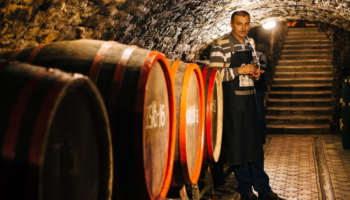Shabo Wine Culture Center is a well-known winery 70 km away from Odesa, whose main objective is to improve the culture of consumption of wine. It is, by far, one of our travellers’ favorite places to visit. What makes the Wine Culture Centre special is the fact that visitors can see and learn about Shabo wine, champagne and brandy production right on the production site; enjoy local wines at a wine tasting and learn the fascinating, multi-layered history behind this place. And it sure is one worth learning!
People have lived in this area for a very long time. The first official mentioning of the Shabo village is a map which indicated a Tatar settlement called Asha-Abaga. Translated, it means “Lower Gardens” (at that time ‘gardens’ was a name used for vineyards).
Back then these territories were still under Turkish rule and the local population was only 28 people, all of them involved in viticulture. From a number of indirect sources it was clear that the lands between the sea and Shabo were ideally suited for growing grapes and have served this purpose since the ancient Greek times.
After 1812, when Bessarabia became part of the Russian Empire, the local authorities paid special attention to the vineyards in the area of Ackerman (region in which Shabo is located). In 1816 the first plenipotentiary governor of Bessarabia region was ordered to clean up the old vines and plant new ones. By 1820 the local population grew by 275 people – these were mostly Ukrainians and Moldavians peasants, who were well able to cultivate the land, to grow wheat, vegetables, but had no idea about the intricacies of viticulture.
Luckily, at that same time a famous Swiss botanist, educator and winemaker Louis Vincennes Tardan took interest in the settlements of Bessarabia and saw it as a ‘promised land’ for winemakers. He presented his idea of moving a small number of experienced winegrowers from Switzerland to the Shabo area, to the tsarist government and it immediately received the highest approval. After a couple familiarization trips to the area, in 1822 an imperial order marked the official foundation of a colonists’ settlement from the Swiss canton of Vaud.
“Shabo Wine Culture Center is not only one of Europe’s finest wineries, but it’s part of an educational mission”
By the middle of the 19th century the Swiss had more than 250 people living in the area. All of them were exempt from some taxes and conscription; they were given free land and preferential treatment. In a matter of years, the Swiss settlers achieved great success – in 1825 they had 104 thousand vines; by 1850 – more than 200 thousand; at the end of the 19th century, there were more than 3 million shrubs in the area.
During the First World War marked the beginning of hard times – a large number of men were mobilized into the army, horses and produce were regularly requisitioned for the needs of the front. Starting 1918 Shabo was under the rule of Romania – as a result of mass requisitions and total devastation, this once prosperous region suffered from famine resulting in numerous deaths. The population of the village decreased dramatically from 4,800 before the First World to 1350 in the early 30s. Under the authority of the Romanians Shabo experienced an economic crisis as a huge domestic market of the former Russia was lost for the marketing of wine. During the Great Patriotic War (from 1941 to 1944) Shabo was occupied by the Germans and Romanians. All Swiss descendants left Shabo together with the Germans. In the years following the war the operation of vineyards in Shabo was reorganized and recreated.
2009 marked a rebirth of the viticulture in the region. Shabo Wine Culture Center is not only one of Europe’s finest wineries, but it’s part of an educational mission – to awaken the respect for centuries-old national traditions, to raise awareness about the CULTURE of wine making and consumption, about wine in world history, and as part of the cultural heritage of the people of Ukraine.








